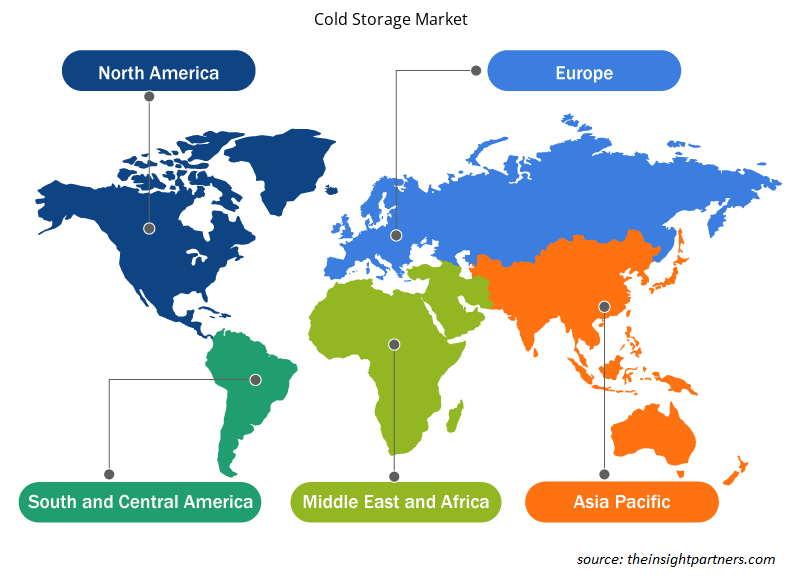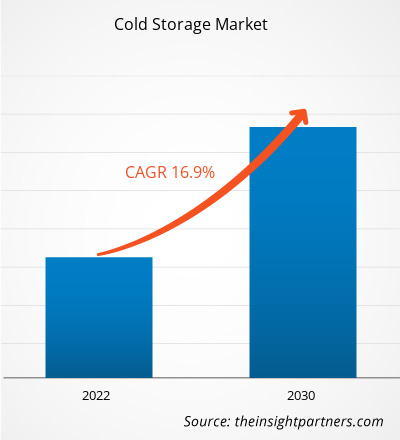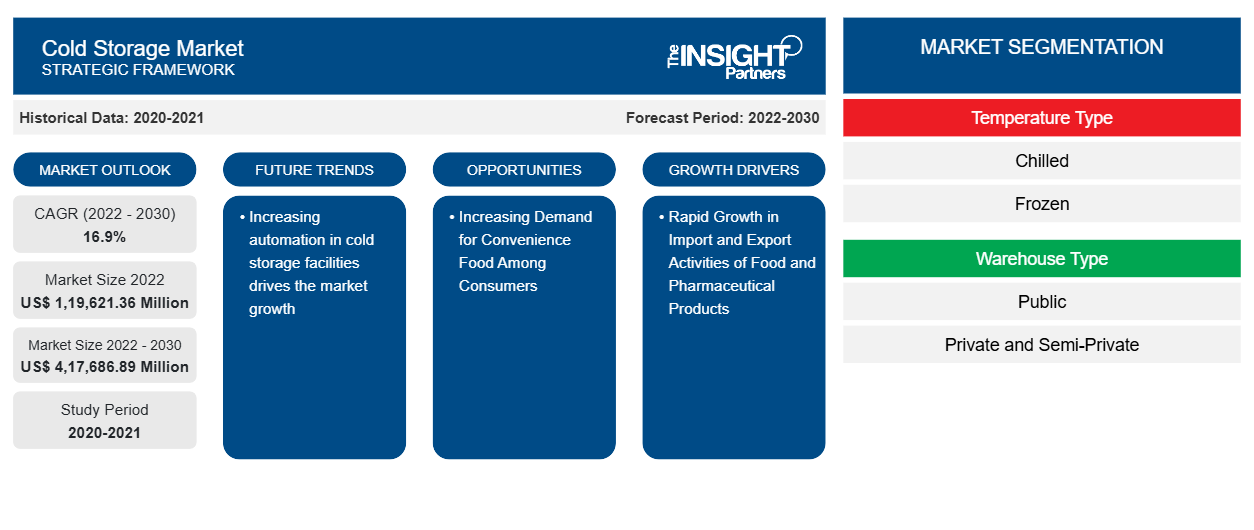من المتوقع أن يصل حجم سوق التخزين البارد إلى 4،17،686.89 مليون دولار أمريكي بحلول عام 2030 من 1،19،621.36 مليون دولار أمريكي في عام 2022. ومن المتوقع أن يسجل السوق معدل نمو سنوي مركب بنسبة 16.9٪ في الفترة 2022-2030.
إن تفضيل المستهلك المتزايد للأطعمة المعلبة المعالجة وسهلة الطهي يعزز الطلب على مرافق التخزين البارد. بالإضافة إلى ذلك، فإن التبني المتزايد للتسوق متعدد القنوات للبقالة وانتشار التسوق عبر الإنترنت يفيد أيضًا سوق التخزين البارد على مستوى العالم. يفكر المستهلكون في التسوق عبر الإنترنت للبقالة لأنه آمن ويساعد في توفير الوقت. كما أن قطاع الأغذية والمشروبات المزدهر، بسبب الطلب المتزايد على المنتجات الغذائية المعلبة والمجمدة، جنبًا إلى جنب مع التطور في قطاع الأدوية، يدفع أيضًا سوق التخزين البارد العالمي
تحليل سوق التخزين البارد
إن النمو السكاني، والتوسع الحضري المتزايد، وزيادة الدخل المتاح، ونمط الحياة المزدحم، كلها عوامل تدفع الطلب على الأطعمة المصنعة والمعلبة وسهلة التحضير على مستوى العالم. وتتطلب الأطعمة المعلبة أو الجاهزة مرافق تخزين مناسبة لتكون في حالة صالحة للاستهلاك. ولا يمكن إنكار أهمية مرافق التخزين البارد، حيث أن الأطعمة المصنعة معرضة بشكل كبير للتعفن في غضون أيام أو أسابيع قليلة إذا لم يتم حفظها بشكل جيد. وتعتبر درجة الحرارة المثلى وظروف التخزين المناسبة ضرورية لإطالة العمر الافتراضي للأطعمة المصنعة أو المعلبة.
نظرة عامة على سوق التخزين البارد
التخزين البارد هو مرفق تخزين حصري يستخدم لتخزين السلع أو المنتجات الحساسة للحرارة، وغالبًا ما تكون قابلة للتلف، بما في ذلك الأطعمة المجمدة والمنتجات الطازجة والمنتجات الصيدلانية. تساعد مرافق التخزين البارد على ضمان سلامة المنتجات القابلة للتلف ونضارتها وسلامتها. ينقل منتجو الفواكه والخضروات والمأكولات البحرية والأسماك والأطعمة المصنعة والمنتجات الصيدلانية في الشرق الأوسط وأفريقيا منتجاتهم لمزيد من المعالجة والتصنيف. بعد حصاد المحاصيل أو ذبح الدجاج واللحوم ولحم الخنزير، يتم نقل المحاصيل الخام والمنتجات التي يتم إنتاجها في الشرق الأوسط وأفريقيا إلى مراكز المعالجة للتعبئة والتغليف.labelling. After harvesting crops or slaughtering chicken, beef, and pork, the raw crops and Middle East and Africa-based products are transported to processing hubs for packaging.
قم بتخصيص هذا التقرير ليناسب متطلباتك
ستحصل على تخصيص لأي تقرير - مجانًا - بما في ذلك أجزاء من هذا التقرير، أو تحليل على مستوى الدولة، وحزمة بيانات Excel، بالإضافة إلى الاستفادة من العروض والخصومات الرائعة للشركات الناشئة والجامعات
- احصل على أهم اتجاهات السوق الرئيسية لهذا التقرير.ستتضمن هذه العينة المجانية تحليلاً للبيانات، بدءًا من اتجاهات السوق وحتى التقديرات والتوقعات.
رؤى إقليمية حول سوق التخزين البارد
لقد قام المحللون في Insight Partners بشرح الاتجاهات والعوامل الإقليمية المؤثرة على سوق التخزين البارد طوال فترة التوقعات بشكل شامل. يناقش هذا القسم أيضًا قطاعات سوق التخزين البارد والجغرافيا في جميع أنحاء أمريكا الشمالية وأوروبا ومنطقة آسيا والمحيط الهادئ والشرق الأوسط وأفريقيا وأمريكا الجنوبية والوسطى.

- احصل على البيانات الإقليمية المحددة لسوق التخزين البارد
نطاق تقرير سوق التخزين البارد
| سمة التقرير | تفاصيل |
|---|---|
| حجم السوق في عام 2022 | 1,19,621.36 مليون دولار أمريكي |
| حجم السوق بحلول عام 2030 | 4,17,686.89 مليون دولار أمريكي |
| معدل النمو السنوي المركب العالمي (2022 - 2030)CAGR (2022 - 2030) | 16.9% |
| البيانات التاريخية | 2020-2021 |
| فترة التنبؤ | 2022-2030 |
| القطاعات المغطاة | حسب نوع درجة الحرارة
|
| المناطق والدول المغطاة | أمريكا الشمالية
|
| قادة السوق وملفات تعريف الشركات الرئيسية |
|
كثافة اللاعبين في سوق التخزين البارد: فهم تأثيرها على ديناميكيات الأعمال
يشهد سوق التخزين البارد نموًا سريعًا، مدفوعًا بالطلب المتزايد من المستخدم النهائي بسبب عوامل مثل تفضيلات المستهلكين المتطورة والتقدم التكنولوجي والوعي المتزايد بفوائد المنتج. ومع ارتفاع الطلب، تعمل الشركات على توسيع عروضها والابتكار لتلبية احتياجات المستهلكين والاستفادة من الاتجاهات الناشئة، مما يؤدي إلى زيادة نمو السوق.
تشير كثافة اللاعبين في السوق إلى توزيع الشركات أو المؤسسات العاملة في سوق أو صناعة معينة. وهي تشير إلى عدد المنافسين (اللاعبين في السوق) الموجودين في مساحة سوق معينة نسبة إلى حجمها أو قيمتها السوقية الإجمالية.
الشركات الرئيسية العاملة في سوق التخزين البارد هي:
- شركة كونستليشن كولد لوجيستكس المحدودة
- نفطة فريجوريفيكوس سا دي سي في
- سوبر فريو ارمازنز جيرايس SA
- مجموعة تيبمان
- شركة نيشيري
- فريالسا فريجوريفيكوس سا دي سي في
إخلاء المسؤولية : الشركات المذكورة أعلاه ليست مرتبة بأي ترتيب معين.

- احصل على نظرة عامة على أهم اللاعبين الرئيسيين في سوق التخزين البارد
أخبار سوق التخزين البارد والتطورات الأخيرة
يتم تقييم سوق التخزين البارد من خلال جمع البيانات النوعية والكمية بعد البحث الأولي والثانوي، والذي يتضمن منشورات الشركات المهمة وبيانات الجمعيات وقواعد البيانات. فيما يلي قائمة بالتطورات في السوق فيما يتعلق بالابتكارات وتوسيع الأعمال والاستراتيجيات:
- في أبريل 2024، أبرمت شركة BOOTES، أول شركة تعمل في مجال الطاقة النظيفة، وشركة CargoPeople، وهي شركة لوجستية متعددة الوسائط مقرها الهند، مشروعًا مشتركًا لإطلاق منشأة تخزين باردة للطاقة النظيفة لتلبية الطلب على تحدي هدر الأغذية والمشروبات الحرج في الهند. (المصدر: Eurofins، بيان صحفي)
تقرير سوق التخزين البارد والتغطية والنتائج المتوقعة
يوفر تقرير "حجم سوق التخزين البارد والتوقعات (2020-2030)" تحليلاً مفصلاً للسوق يغطي المجالات التالية:
- حجم سوق التخزين البارد وتوقعاته على المستويات العالمية والإقليمية والوطنية لجميع قطاعات السوق الرئيسية التي يغطيها النطاق
- ديناميكيات السوق مثل المحركات والقيود والفرص الرئيسية
- اتجاهات سوق التخزين البارد
- تحليل مفصل لـ PEST وتحليل SWOT
- تحليل سوق التخزين البارد يغطي اتجاهات السوق الرئيسية والإطار العالمي والإقليمي واللاعبين الرئيسيين واللوائح والتطورات الأخيرة في السوق.
- تحليل المشهد الصناعي وسوق التخزين البارد والمنافسة التي تغطي تركيز السوق، وتحليل خريطة الحرارة، واللاعبين البارزين، والتطورات الأخيرة.
- ملفات تعريف الشركة التفصيلية
- التحليل التاريخي (سنتان)، سنة الأساس، التوقعات (7 سنوات) مع معدل النمو السنوي المركب
- تحليل PEST و SWOT
- حجم السوق والقيمة / الحجم - عالمي، إقليمي، بلد
- الصناعة والمنافسة
- مجموعة بيانات إكسل
التقارير الحديثة
تقارير ذات صلة
شهادات العملاء
سبب الشراء
- اتخاذ قرارات مدروسة
- فهم ديناميكيات السوق
- تحليل المنافسة
- رؤى العملاء
- توقعات السوق
- تخفيف المخاطر
- التخطيط الاستراتيجي
- مبررات الاستثمار
- تحديد الأسواق الناشئة
- تحسين استراتيجيات التسويق
- تعزيز الكفاءة التشغيلية
- مواكبة التوجهات التنظيمية























 احصل على عينة مجانية ل - سوق التخزين البارد
احصل على عينة مجانية ل - سوق التخزين البارد